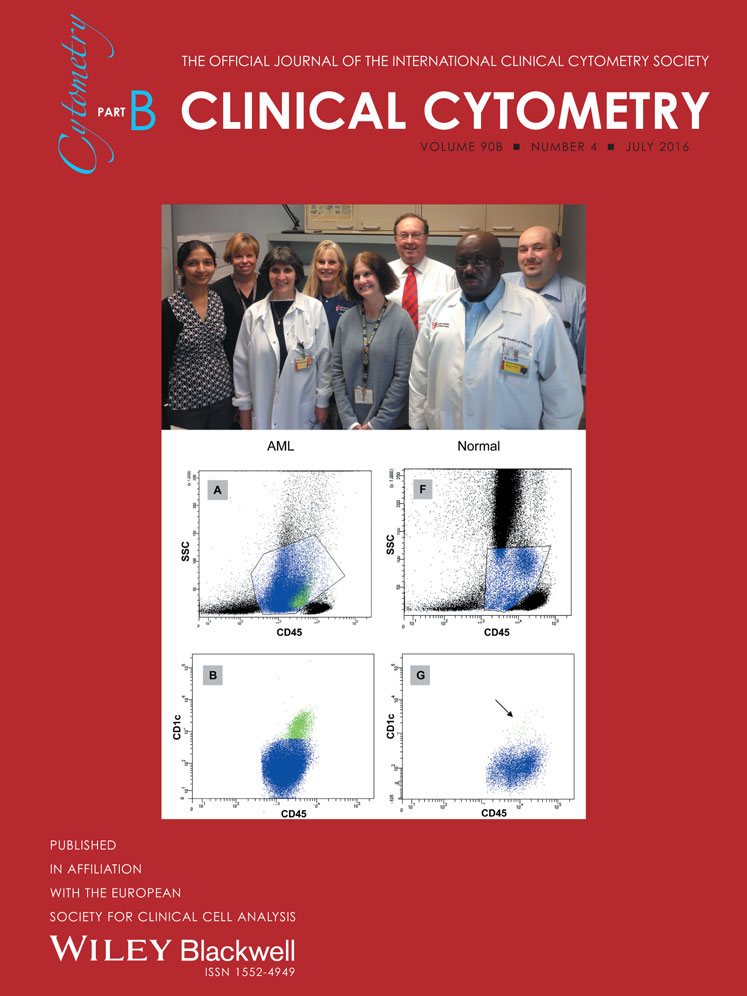Issue highlights – July 2016
THERE ARE SEVERAL WAYS TO STUDY MDS
Myelodysplastic syndrome (MDS) has increasingly been investigated in the past decades due to the more comprehensive diagnostic approach that now involves multiparameter flow cytometry (MFC). In recent publications, myeloid cells obtained from cytopenic patients with suspected MDS have been characterized extensively and the cases where MDS was verified by phenotypic changes have been shown to be associated with worse overall survival compared to MFC-negative cases in a large patient cohort 1. These authors investigated scatter properties, increased count of myeloid progenitor cells and aberrant phenotypes on myeloid cells in bone marrow aspirates. Phenotypic alterations have been extensively studied in MDS and aberrant marker expression has been described in numerous cell types even in platelets of peripheral blood samples 2. In the recent issue of Cytometry B, two papers dealing with MDS from different perspectives call our attention to important laboratory issues. Evaluation of side scatter (SSC), which is an indication of the ‘complexity’ and granularity of neutrophils by flow cytometry is an important parameter and a diagnostic and prognostic tool for MDS. In the publication by Alhan and coworkers 3, the authors investigated several preanalytical aspects in MDS analysis particularly the scatter properties of neutrophils that they calculated as a ratio to the SSC of lymphocytes as an internal reference. They indicate that a delay in the time between staining and analysis will result in an increase in the SSC of neutrophils. Moreover, fixation and time delay after fixation enhances this increase in SSC ratio and they found that storing of stained samples at 4ºC further enhanced this effect. They conclude that time-related and fixative related changes might result in an inadequate interpretation of neutrophil SSC.
IS THERE A ‘BEST PRACTICE’ FOR MEASURING MICROVESICLES?
To study small, smaller, smallest was one goal of clinical flow cytometrists and indeed a considerable improvement was seen in the past decade in the analysis of microvesicles also designated in the literature as microparticles. These cellular fragments that range from 0.1 to 1.0 um in diameter are of clinical and pathological importance in numerous disorders as they can signal other cells and harm several organs. However, any particle in the aforementioned size range is not necessarily a microvesicle since endosomes, lipoproteins and protein aggregates may also give a signal in this size. Nevertheless, it is very important to be able to measure the real microvesicles as extracellular vesicle secretion represents a universal and highly conserved active cellular function and many pieces of evidence support that extracellular vesicles may serve as biomarkers and therapeutic targets or tools in human diseases 5. Thus, the standardization of microvesicle measurement is highly desirable. Although today several techniques have been proposed for microvesicle analysis like dynamic light scattering, nanoparticle tracking analysis, resistive pulse sensing or scanning and atomic force microscopy, only flow cytometry can provide the advantage of measuring a large number of samples at a reasonable cost and effort, determine the cellular origin and determine if a particle is a lipid microvesicle or immune complex or precipitate. In his review in the recent volume of the Journal Wayne L. Chandler 6 summarizes important aspects of microvesicle measurement standardization. In this thoughtful summary it is demonstrated that the majority of the annexin V positive microvesicles in human blood are below 500 nm, so it is no wonder that more sophisticated cytometers that can detect particles well below 500 nm measure much higher microvesicle counts compared to previously published results. The author calls attention to the utilization of appropriate controls. These are required to critically evaluate the results like dilution experiments that should be carried out to avoid the effect of swarming. Swarming may result in underestimation of the total microvesicle number and an overestimation of large microvesicle numbers. Another important technical aspect is that by using calibration beads we need to take into consideration the refractive indices of the appropriate beads. In this respect polystyrene beads will not provide the same signal as the same sized microvesicles and silica has been suggested as a better light calibration standard since its refractive index is much closer to that of lipid microvesicles 7. These and many similar considerations will contribute to the better standardization of flow cytometric microvesicle analysis and will probably eliminate the 2-3 orders of magnitude differences in normal peripheral blood microvesicle counts that were reported in the past decades.
János Kappelmayer*
Debrecen, Hungary





